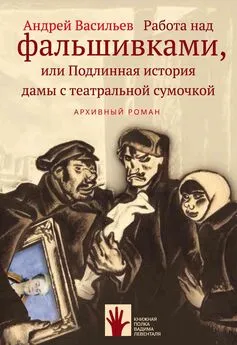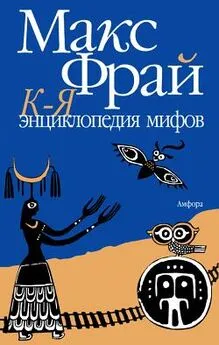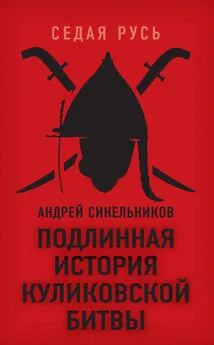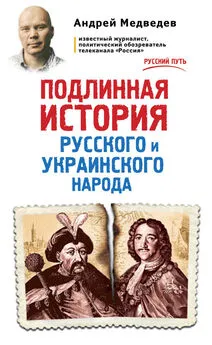Андрей Васильев - Работа над фальшивками, или Подлинная история дамы с театральной сумочкой
- Название:Работа над фальшивками, или Подлинная история дамы с театральной сумочкой
- Автор:
- Жанр:
- Издательство:ИД «Городец»
- Год:2021
- Город:Москва
- ISBN:978-5-907358-00-3
- Рейтинг:
- Избранное:Добавить в избранное
-
Отзывы:
-
Ваша оценка:
Андрей Васильев - Работа над фальшивками, или Подлинная история дамы с театральной сумочкой краткое содержание
Как высочайшего класса расследование эта книга подробно рассказывает о потайных механизмах функционирования арт-рынка; как роман — обращается к глубинам человеческой природы.
Работа над фальшивками, или Подлинная история дамы с театральной сумочкой - читать онлайн бесплатно ознакомительный отрывок
Интервал:
Закладка:
Nicholas Cullinan, “Color Masses”, in Malevich, ed. Achim Borchardt-Hume, London, Tate Publishing, 2014, p. 121
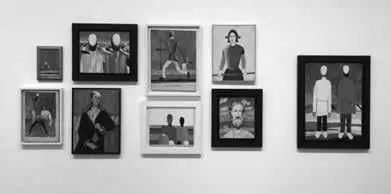
UNA URIMAN: ABOUT E. YAKOVLEVA
Elizaveta Iakovleva, painter and theater artist, studied in St. Petersburg at the studio of Mikhail Bernshtein with Boris Anisfeld and Leonid Shervud. She worked for the Bolshoi Dramatic Theater and he Theater of Musical Comedy in Leningrad as a costume and set designer. She took part in the Theatrical and Decorative Arts 1917-27 exhibition in Leningrad in 1927. In the early 1930s Malevich painted her portrait (Nakov, Cat. Raisonne, p. 403, PS-253)
Una, Malevich's daughter, recounts her memories of E. Yakovleva recorded by Nina Suetina, and transcribed and annotated by Irina Vakar as follows:
In 1932 Papa took me to live with him in Leningrad. […] Every evening guest gathered at Papa's, there were always ten to twelve people sitting at the table. […] Of those who visited Papa's apartment I remember: Anna Alexandrovna, Nikolai Mikhailovich, Konstantin Ivanovich, Elizaveta Iakovleva* — she was a small- time painter, she kept coming every day, and they loved her at our place.
Una Uriman, “About my Father” in Kazimir Malevich. Letters, Documents, Memoirs, Criticism, Volume 2, Kazimir Malevich: Memoirs and Criticism, eds. Irina A. Vakar and Tatiana N. Mikhienko, London, Tate Publishing 2015, p. 31
PROF. CHARLOTTE DOUGLAS: AVANT-GARDE RUSSIAN TEXTILE DESIGN
World War I, the two revolutions, and the civil war did not disrupt the pace of innovation in Russian fabric design. Under new slogans of revolution, internationalism, and classlessness, Suprematist and Constructivist design continued until the late 1920s, when geometric design — on clothing or any other fabric — became politically suspect, and was forced out by a younger generation of artists.
Suprematist design then acquired an even greater importance for Malevich. In his late portraits it has emblematic, philosophical, and even counterrevolutionary significance. In 1934 Malevich painted a splendid portrait of the Leningrad theater designer Elizaveta Iakovleva (illustrated on the same page of the journal as this text.). Dressed in a cadmium yellow hat and a coat with a Suprematist collar, she slyly exhibits a bright red Suprematist handbag. This painting has recently been discovered. Most of the actual fabric and other articles have been lost or destroyed. We must be grateful indeed for Sayler's photographs.
Charlotte Douglas, “Suprematist Embroided Ornament,” in Art Journal, Vol. 54 No. 1, Spring1995, p. 45
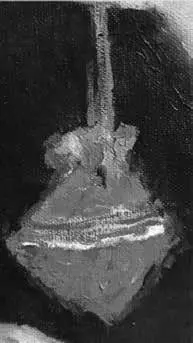
Portrait of E. Yakovleva, detail handbag
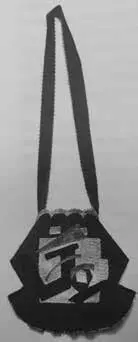
Olga Rozanova, appliqued handbag, 1916–1917
Symbolism is unquestionably the foundation of his aesthetics.
DR. ANDREI NAKOV, Specialist Russian Avant-Garde
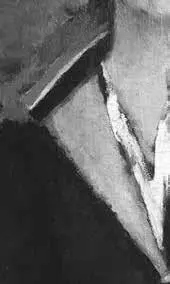
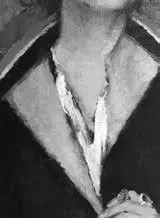
Portrait of E. Yakovleva, collar details

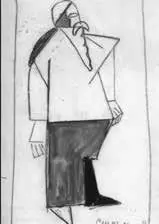
Sketches of costumes for the opera Victory Over the Sun by M. Matyushin and A. Kruchenykh, 1913, details
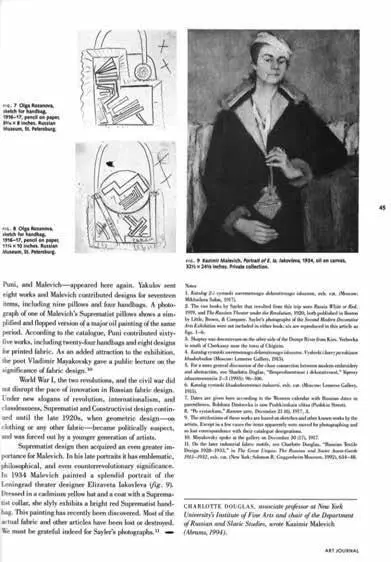
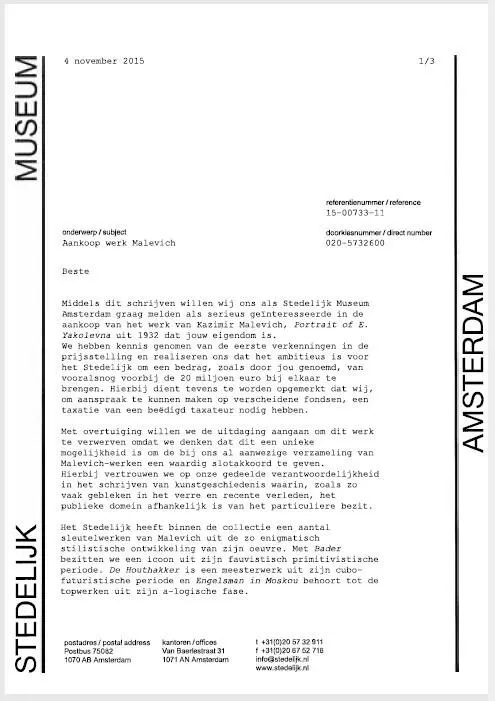
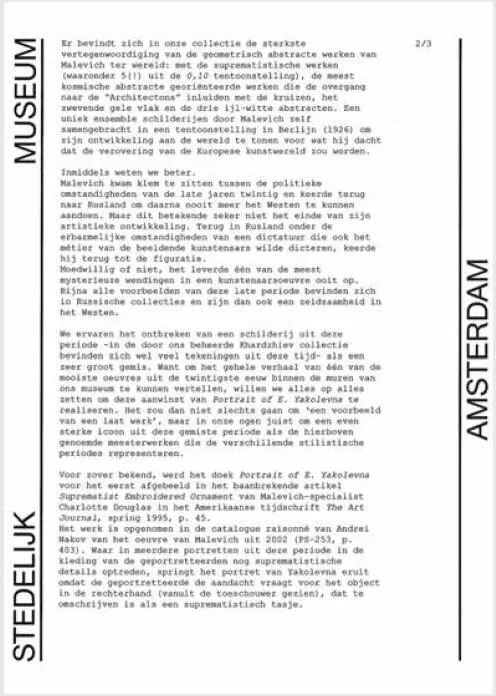
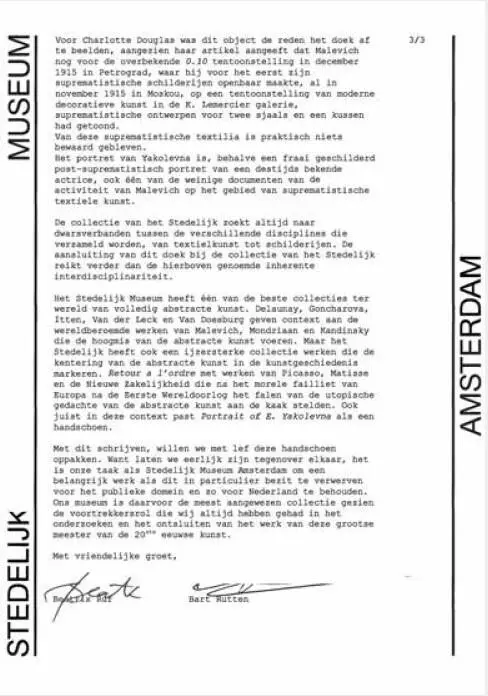
TRANSLATION STEDELIJK MUSEUM LETTER
4 November 2015
Subject:
Purchase of artwork by Malevich
With the present letter we, as the Stedelijk Museum Amsterdam, hereby state our serious interest in purchasing the work by Kazimir Malevich, Portrait of E. Yakolevna from 1932, which you are the owner of.
We have taken note of the first discussions of pricing and given that the amount mentioned by you exceeds 20 million euros, it is an ambitious amount for the Stedelijk to bring together. It should therefore be noted that we, in order to be entitled to such funds, need a valuation report from an officially recognized art appraiser.
We are determined to take up the challenge of acquiring this work because we see this as a unique opportunity to complement our existing collection of Malevich works.
We hereby rely on our shared responsibility of writing art history wherein, as often shown in the distant and recent past, the public domain is dependent on private ownership.
The Stedelijk has in its collection a number of key-works by Malevich from this very enigmatic stylistic development of his oeuvre. With Bather we own an icon from his fauvist — primitive period. Woodcutter is a masterwork from his cubo-futurist period and Englishman in Moscow belongs to the top works from his a-logic phase.
Our collection has the strongest representation of geometric abstract works of Malevich in the world: from the Suprematist works (including 5 (!) from the O.lO exhibition), to the most cosmic oriented abstract works that herald the transition to the “Architectons“ with the crosses, the floating yellow plane and the three thin white abstracts. This is a unique ensemble of paintings brought together by Malevich in an exhibition in Berlin (1926) to show the world his artistic developments that he thought would conquer the European art world.
We although know better by now.
Malevich got stuck because in the political conditions of the late 1920s and returned to Russia, never to come back to the West. But this certainly did not mean the end of his artistic development. Back in Russia under the harsh conditions of a dictatorship that wanted to also dictate the artistic developments, he returned to the figurative.
Intentionally or not, he produced one of the most mysterious twists ever in the oeuvre of an artist. Almost all examples of this late period are to be found in Russian collections and are therefore a rarity in the West.
We experience the lack of a painting from this period — as in the Khardzhiev Collection that is managed by us there are many drawings from this time- as a very great loss. In order to be able to tell the story of one of the most beautiful oeuvres of the twentieth century on the wails of our museum, we want to uo everything possible to accomplish the acquisitions oi Portrait of E. Yakolevna. The intention is not only to acquire “an example of a late work” but in our eyes an equally strong icon from this missed period just as the aforementioned masterworks that represent the different stylistic periods.
To our knowledge, the painting Portrait of E. Yakolevna has first been illustrated in the groundbreaking article Suprematist Embroidered Ornament by Malevich specialist Charlotte Douglas in the American magazine The Art Journal, spring 1995, p. 45.
The work is included in the catalog raisonne by Andrei Nakov on the oeuvre of Malevich from 2002 (PS-253, p. 403). While in several portraits from this period Suprematist details appear in the clothing of the portrayed characters, the portrait of E. Yakolevna stands out because the sitter draws attention to the object in her right hand (seen by the onlooker), which is described as a Suprematistic handbag.
For Charlotte Douglas this object was the reason for illustrating the painting, as her article explains that Malevich had already shown two Suprematist shawls and a cushion in the well known 0:10 exhibition from 15 December in Petrograd. He showed for the first time in public his Suprematist paintings already in November 1915 in Moscow, in an exhibition of modern decorative art in the K. Lemercier Gallery.
From these Suprematist textiles practically nothing remains.
The Portrait of Yakolevna is not only a beautifully painted post-Suprematist portrait of a then well-known actress, but also one of the few documents recording Malevich's activities in the field of Suprematist textile art.
The Stedelijk's collection is always looking for connections between the different disciplines that are collected, from textile art to paintings. Adding this paintingto the collection of the Stedelijk further enriches the above-mentioned inherent interdisciplinarity.
The Stedelijk Museum has one of the best abstract art collections in the world. Delaunay, Goncharova, Itten, Van der Leck en Van Doesburg complement and contextualize other major works of Malevich, Mondriaan and Kandinsky in our collection. The Stedelijk also has an extremely strong collection of works that marked the reversal of abstract art in the history of art. There was a “retour a 1'ordre” with works by Picasso, Matisse and the New Objectivity, which after the moral collapse of Europe after WWI addressed the failure of the utopian idea of abstract art. It is precisely in this context that Portrait of E. Yakolevna fits like a glove.
With this letter we want to convey to you our sincere intention to do everything in our power to make this acquisition possible. To be honest, it is our task as the Stedelijk Museum Amsterdam to acquire such an important work from private ownership and bring it to the public domain and preserve it in The Netherlands. Our museum is therefore the most appropriate collection for this painting, given the pioneering role we have always had in researching and unlocking the work of this great master of the twentieth century.
Sincerely,
Beatrix Ruf
Bart Rutten
Примечания
1
Флоренский П. А. Иконостас. М., 1994. С. 65.
2
См. Приложение 2.
3
Здесь и далее речь идет о ЦГА СПб и ЦГАЛИ СПб.
4
В октябре 2017 года в музее столицы Восточной Фландрии открылась выставка, состоящая исключительно из сомнительных работ неясного происхождения. Следствие и разбирательства по этому поводу продолжаются до сих пор.
Подробную информацию на этот счет можно почерпнуть здесь: https://ru.wikipedia.org/wiki/Топоровский,_Игорь_Владимирович
Читать дальшеИнтервал:
Закладка:
